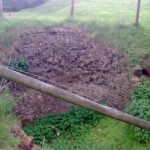This site has been occupied for thousands of years, and there is evidence of this all around the farm. From the Standlow Barrows at the highest point to the hollow in which the house sits, and in the landscape beyond, there are signs of human habitation.
The Barrows are part of a ring of burial sites in the area dating back about 4000 years. Re-use of part of the Barrows in Anglo-Saxon times has been found, and artefacts from the mounds were sent to the British Museum in the 19th c.
There is much remaining of the ridge and furrow field system, both here and on nearby farms. This medieval farming system, also known as strip farming, predates the walls and hedges on this farm. It is particularly visible in the early morning and late evening as the angle of the sun casts shadows across the furrows.
Lead mining, quarrying for limestone, sand, and gravel extraction have occurred over the past few hundred years. Processing of limestone for building and farming purposes took place here, as can be seen from the two lime kilns on the farm. The most recent quarrying took place during the 2nd World War.
The farmhouse and stone buildings date from some time in the 18th century, and the newer buildings are mid-20th c. There have been changes to the use of buildings over the years – part of the house was used for cheese-making, but is now the kitchen! And the holiday cottage housed animals.
A Trail leaflet is available to guide you around the farm – ask Bob for one on arrival.
The Archeological Trial
The land we farm at New House Farm is rich in Archaeological finds and features.
We have put together an archaeology trail that you can use on your visit to explore the land in more detail and discover 4000 years of human usage

- The Hedgerows
- The Fields
- The Gravel Pit
- The Bottle Lime Kiln
- The Quarry Workings
- The Lead Mining
- Stand Low Barrows
- The Dew pond
- The Farmyard


